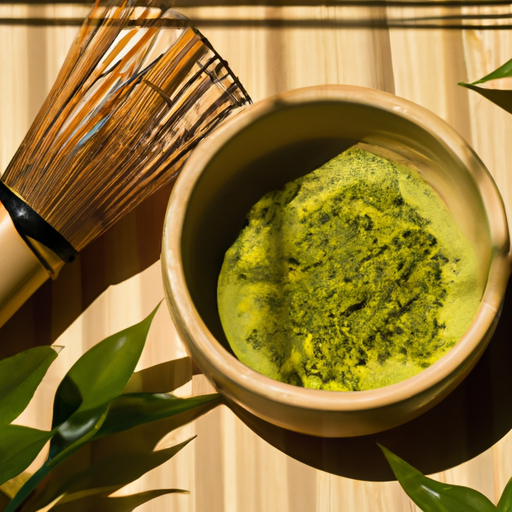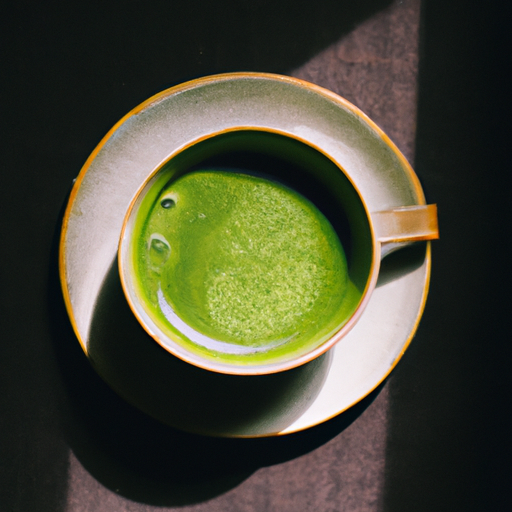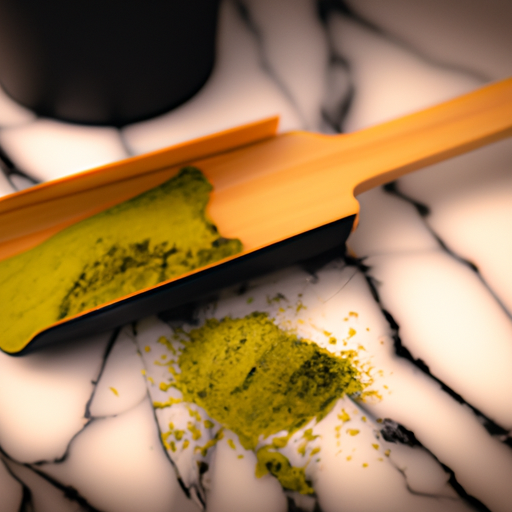As an enthusiast of both the flavor and health advantages of matcha green tea smoothies, I’m constantly on the hunt to try out fresh tastes and components. A simple method to diversify my smoothie repertoire is by mixing in various fruits.
Not only do fruits add natural sweetness and flavor, but they also provide essential nutrients and antioxidants that complement the benefits of matcha. In this article, I will delve into the world of fruit and matcha green tea smoothies, exploring the best options and tips for achieving the perfect balance of taste and nutrition.
Matcha green tea smoothies are becoming increasingly popular among health enthusiasts due to their numerous benefits. Matcha is a type of green tea that is finely ground into a powder, which is then mixed into smoothies or other recipes. Unlike regular green tea, matcha contains the entire tea leaf, resulting in a higher concentration of antioxidants and other beneficial compounds.
Matcha is also known for its ability to improve focus, boost metabolism, and support overall health and well-being. Adding fruit to matcha smoothies not only enhances the taste but also provides additional vitamins, minerals, and fiber to support a healthy lifestyle.
Key Takeaways
- Fruit can enhance the taste of matcha green tea smoothies while providing additional vitamins, minerals, and fiber.
- Some recommended fruit pairings include oranges, grapefruits, lemon, papaya, kiwi, coconut, pineapple, avocado, and ginger.
- Balancing sweet vs. tart, texture, and color is important for achieving the desired flavor and mouthfeel.
- Regular consumption of matcha green tea smoothies and fruit can provide numerous health benefits, including improved brain function, increased energy levels, reduced inflammation, and support for digestion, heart health, and healthy skin.
Benefits of Matcha Green Tea Smoothies
Drinking matcha green tea smoothies regularly can provide a multitude of health benefits, including improved brain function and increased energy levels. Matcha green tea is loaded with antioxidants and can help reduce inflammation in the body. It also contains L-theanine, an amino acid that boosts the production of dopamine and serotonin, which can improve mood and reduce stress levels.
The benefits of incorporating matcha green tea into your diet are endless, and there are many creative ways to use matcha green tea in recipes. Matcha green tea can be added to smoothies, baked goods, and even savory dishes like soups and sauces. It can also be used as a natural food coloring agent, giving dishes a beautiful green hue.
Adding fruit to your matcha green tea smoothie is important to not only enhance the flavor, but also to increase the nutritional value. Fruits like bananas, strawberries, and blueberries are great options to add to your smoothie. They provide natural sweetness and are packed with vitamins, minerals, and fiber. By incorporating fruits into your matcha green tea smoothie, you can create a delicious and nutritious beverage that is perfect for any time of the day.
Importance of Adding Fruit
Adding a juicy and flavorful ingredient to your matcha blend can enhance the overall taste experience. But it’s not just about taste – incorporating fruit into your smoothie can also provide a range of benefits. Fruits are packed with vitamins, minerals, and antioxidants that can promote good health and well-being.
One of the benefits of incorporating fruit into smoothies is that it can help you meet your daily recommended intake of fruits. According to the USDA, adults should consume at least 1 1/2 to 2 cups of fruit per day. By adding fruit to your smoothie, you can easily boost your fruit intake and reap the health benefits that come with it.
Additionally, fruits are low in calories and high in fiber, which can help you feel full and satisfied, making it easier to stick to a healthy diet.
Different ways to prepare fruit for smoothies include blending, chopping, and freezing. When blending, make sure to remove any seeds or pits and chop the fruit into small pieces to ensure a smooth consistency. Alternatively, you can chop the fruit into bite-sized pieces and add them to the smoothie after blending. Freezing fruit beforehand can also add a refreshing element to your smoothie and make it creamier without adding any dairy.
Adding fruit to your matcha smoothie is a great way to add flavor and nutrition. In the next section, we’ll explore the best fruits to add to your matcha blend for the ultimate taste experience.
Best Fruits to Add
To truly elevate your matcha blend, you’ll want to explore the world of fruit pairing – just like how a good wine complements a meal. Think of your matcha smoothie as a canvas and the fruits as the paintbrush, each stroke adding depth and complexity to the final masterpiece.
Flavor combinations are crucial when it comes to matcha smoothies and adding fruits can help balance out the earthy, bitter taste of matcha. When it comes to adding fruits to your matcha smoothie, there are a multitude of options to choose from.
Some of the best fruits to add include tropical fruits like pineapple and mango, which add a sweet and tangy flavor to the smoothie. Additionally, berries like strawberries and blueberries add a tartness that complements matcha’s natural bitterness. For those looking to add a bit of creaminess to their smoothie bowl, avocado is a great choice.
In terms of smoothie bowl ideas, the options are endless. For a tropical twist, try blending matcha with pineapple, mango, and coconut milk. For a tart and refreshing option, blend matcha with strawberries, blueberries, and a splash of lemon juice. Adding a banana to your matcha smoothie can also give it a creamier texture.
When it comes to berries to consider, raspberries and blackberries are a great choice due to their tartness and ability to balance out the flavor of matcha.
Berries to Consider
When I’m making a matcha green tea smoothie, I love adding some berries to give it an extra burst of flavor and nutrition.
My top picks are blueberries, strawberries, and raspberries.
Not only do they taste delicious, but they’re also packed with antioxidants and other beneficial nutrients.
These can enhance the health benefits of the smoothie.
Blueberries
As I indulge in a matcha green tea smoothie, I find that blueberries make for a delightful addition with their burst of sweet and tart flavors. Blueberries aren’t only delicious, but they’re also packed with antioxidants and vitamins that can benefit our overall health.
Here are some blueberry combinations and smoothie recipes that you can try to elevate your matcha green tea smoothie experience:
- Blueberry and banana smoothie
- Blueberry and spinach smoothie
- Blueberry and almond milk smoothie
- Blueberry and Greek yogurt smoothie
- Blueberry and honey smoothie
Adding blueberries to your matcha green tea smoothie can make it even more nutritious and delicious.
Speaking of berries that go well with matcha green tea smoothie, strawberries are another great option.
Strawberries
Ah, the sweet and juicy taste of strawberries – a perfect addition to any blended beverage, especially a matcha green tea smoothie. Not only do strawberries add a refreshing flavor, but they also bring a host of health benefits to the table. These little red berries are packed with antioxidants, fiber, and vitamin C, making them an excellent choice for those looking to boost their immune system and promote healthy digestion.
When it comes to recipe variations, there are a few ways to incorporate strawberries into your matcha smoothie. You could blend them in with the other ingredients for a smooth and creamy texture, or you could add them as a topping for a crunchy and sweet finish. To keep things simple, try blending together 1 cup of frozen strawberries, 1 cup of almond milk, 1 teaspoon of matcha powder, and 1 tablespoon of honey for a delicious and nutritious smoothie.
Now, let’s move on to the next fruit – raspberries.
Raspberries
You’ll love luscious raspberries in your blended beverage, as they bring a burst of bright flavor and bountiful health benefits. Raspberries are low in calories but high in fiber and antioxidants, making them a perfect addition to any smoothie.
Here are some raspberry pairing ideas to take your raspberry smoothie to the next level:
- Add banana for creaminess and sweetness
- Mix in some spinach for added nutrients
- Combine with almond milk for a nutty flavor
- Top with chia seeds for extra protein and texture
With these pairing ideas, your raspberry smoothie will not only taste delicious but also provide a nutritious start to your day.
Now, let’s move on to another fruit that pairs well with matcha green tea smoothie – citrus fruits.
Citrus Fruits
When it comes to pairing citrus fruits with matcha green tea smoothies, I’ve found that oranges, grapefruits, and lemons work particularly well.
Oranges add a sweet and tangy flavor, while grapefruits provide a slightly bitter and refreshing taste.
Lemons, on the other hand, offer a tart and zesty kick that enhances the earthy notes of matcha.
These citrus fruits also contain high levels of vitamin C and antioxidants, making them a healthy and flavorful addition to any smoothie.
Orange
Adding a juicy orange to your matcha green tea smoothie creates a refreshing and citrusy twist to your beverage. This juice pairing not only adds a burst of flavor to your drink, but also provides several health benefits.
Here are four reasons why an orange is the perfect fruit to pair with matcha green tea:
-
High Vitamin C content: Oranges are known for their high vitamin C content, which helps boost immune function and protect against colds and flu.
-
Antioxidants: Matcha green tea is also high in antioxidants, and when combined with orange, the drink becomes a powerhouse of free-radical-fighting compounds.
-
Fiber: Oranges are an excellent source of fiber, which helps regulate digestion and promote satiety.
-
Flavor combinations: The sweet and tangy flavor of oranges pairs perfectly with the earthy and slightly bitter taste of matcha green tea, creating a balanced and delicious drink.
As we move on to the next subtopic of grapefruit, it’s important to note that while oranges and grapefruits are both citrus fruits, they have distinct flavor profiles and health benefits.
Grapefruit
Grapefruit, with its tangy and slightly bitter taste, offers a unique flavor profile that can enhance the taste of your favorite beverages. It pairs well with matcha green tea smoothie, as the strong flavors of matcha can balance out the sourness of grapefruit.
Additionally, grapefruit is low in calories and high in vitamin C, making it a healthy addition to your smoothie. When paired with matcha, grapefruit can also boost the nutritional benefits of your smoothie. Matcha is rich in antioxidants and supports brain function, while grapefruit contains antioxidants and essential nutrients that support immune function.
Together, they create a delicious and nutrient-packed smoothie that can help you stay healthy and energized.
Moving on to the next subtopic, lemon is another citrus fruit that can be combined with matcha for a refreshing and zesty flavor.
Lemon
You may be surprised to find that a simple squeeze of lemon into your matcha drink can transform its flavor, giving it a refreshing and zesty twist that will wake up your taste buds. Not only does lemon add a burst of flavor, but it also has health benefits.
Lemon is packed with vitamin C which is essential for a strong immune system. It also contains antioxidants that help fight off harmful free radicals in the body. Lemon juice can also aid in digestion and promote healthy skin.
When it comes to taste pairing, lemon is a great complement to matcha. The sourness of the lemon balances out the bitterness of the matcha, creating a harmonious and delicious blend.
To further enhance the flavor profile of your matcha and lemon smoothie, try adding honey or agave for sweetness, coconut water for a tropical twist, or even some fresh mint for an extra burst of freshness. These simple additions will take your matcha drink to the next level.
Moving on to tropical fruits, there are several options that can be paired with matcha for a delicious and refreshing smoothie.
Tropical Fruits
As someone who loves exploring different flavors and experimenting with new recipes, I’m excited to dive into the world of tropical fruits. Specifically, I want to discuss three fruits that are particularly delicious and nutritious: papaya, kiwi, and coconut.
Not only are these fruits bursting with flavor, but they’re also packed with vitamins, minerals, and antioxidants that can boost our health in a variety of ways. So, let’s take a closer look at the benefits of adding papaya, kiwi, and coconut to our diets and how we can incorporate them into our meals.
Papaya
Blend ripe papaya chunks into your matcha green tea smoothie for a tropical twist that’ll transport you to a sunny beach.
Papaya is a versatile fruit that pairs well with matcha green tea. Here are three papaya pairings that’ll enhance the flavor of your matcha smoothie:
-
Lemon: Add a squeeze of lemon juice to your papaya matcha smoothie to brighten the flavor and add a tangy kick.
-
Coconut milk: Use coconut milk as a base for your smoothie to add creaminess and complement the tropical flavors of papaya and matcha.
-
Ginger: Add a small piece of fresh ginger to your papaya matcha smoothie for a spicy kick that’ll awaken your taste buds.
Now, let’s move on to the next fruit that pairs well with matcha green tea: kiwi.
Kiwi
Despite its small size, kiwi packs a flavorful punch that complements the earthy notes of matcha. When it comes to kiwi pairings, a matcha green tea smoothie is one of the best. The tartness of kiwi blends well with the subtle sweetness of matcha, creating a refreshing and healthy beverage that’s perfect for any time of day.
Not only is this combination tasty, but it also offers numerous health benefits. Kiwis are packed with vitamins C and K, which aid in boosting the immune system and promoting healthy bones. Matcha green tea, on the other hand, is high in antioxidants and can help improve brain function and lower the risk of chronic diseases. Together, they create a powerful duo that not only tastes great but also helps keep your body healthy and happy.
Moving on to the next ingredient, coconut adds a creamy texture to the smoothie and offers its own set of health benefits.
Coconut
Coconut brings a luscious creaminess to drinks and desserts, making it a popular ingredient in many tropical recipes. When it comes to matcha green tea smoothies, coconut can be a perfect addition. Here’s why:
-
Coconut milk is a creamy liquid made from grated coconut flesh. It’s a great dairy-free alternative to regular milk. It adds richness and thickness to the smoothie, making it more satisfying and filling. Coconut milk is also rich in healthy fats, which can help keep you energized and satiated for longer.
-
Coconut water is a clear liquid found inside young green coconuts. It’s a refreshing and hydrating ingredient for smoothies. It has a slightly sweet and nutty flavor that pairs well with matcha green tea. Coconut water is also packed with electrolytes, such as potassium and magnesium, which can help replenish your body after a workout or a hot day.
In addition to these two options, you can also use shredded coconut or coconut cream to add more texture and flavor to your matcha green tea smoothie. Just remember to choose unsweetened and organic coconut products to avoid added sugars and harmful chemicals.
As you can see, coconut is a versatile and nutritious ingredient that can enhance the taste and health benefits of your matcha green tea smoothie. However, if you’re looking for more unique options, there are other fruits and ingredients that can complement matcha green tea in unexpected ways.
Unique Options
If you’re feeling adventurous, try adding some tangy pineapple to your matcha green tea smoothie for a unique flavor combination that will have your taste buds dancing. Pineapple has a sweet and acidic taste that can complement the earthy and bitter notes of matcha. This tropical fruit is also rich in vitamin C, manganese, and bromelain, which can boost your immune system, support digestion, and reduce inflammation.
Another unexpected pairing for matcha green tea smoothie is avocado. Avocado is a creamy and buttery fruit that can add richness and depth to your smoothie without overpowering its delicate flavor. Avocado is also high in healthy fats, fiber, and potassium, which can improve your heart health, regulate your blood sugar levels, and enhance your skin health. To prepare avocado for your smoothie, simply scoop out the flesh and discard the skin and pit.
Lastly, if you want to add a spicy kick to your matcha green tea smoothie, you can try adding some fresh ginger. Ginger has a pungent and warming taste that can balance the coolness and bitterness of matcha. Ginger is also a natural anti-inflammatory and antioxidant that can alleviate nausea, soreness, and oxidative stress. To prepare ginger for your smoothie, simply grate or slice a small piece and blend it with the other ingredients.
Now that you know some unique options for your matcha green tea smoothie, let’s move on to how to prepare fruits that go well with it.
How to Prepare Fruits
To get the most out of your healthy drink, you’ll want to make sure you’re preparing the accompanying ingredients properly. When it comes to fruit, knife skills are essential for enhancing the texture and presentation of your smoothie. Whether you opt for slicing, dicing, or pureeing, it’s important to choose the right technique for the type of fruit you’re using.
Below is a table outlining different fruit preparation techniques and their recommended use:
| Technique | Use |
|---|---|
| Slicing | Ideal for firm fruits like apples, pears, and pineapples |
| Dicing | Best for softer fruits like bananas, strawberries, and mangoes |
| Pureeing | Perfect for creating a smooth and creamy texture with berries, peaches, and avocados |
In addition to knife skills, flavor pairing is also key to creating a delicious matcha green tea smoothie. Some fruits that complement matcha’s earthy flavor include citrus fruits like lemon and lime, as well as tropical fruits like pineapple and mango. Experiment with different combinations to find the perfect balance of sweet and bitter flavors.
By properly preparing your fruit and pairing flavors, you can enhance the taste and nutritional value of your matcha green tea smoothie. However, balancing flavor is also important for creating a well-rounded drink. In the next section, we’ll explore some tips for achieving this balance.
Tips for Balancing Flavor
When it comes to balancing flavors in smoothies, there are three key factors I always consider: sweet vs. tart, texture, and color.
Sweet and tart flavors need to be carefully balanced to avoid overwhelming the taste buds.
Texture is also important, as it can add depth and interest to the drink.
Lastly, color can be used to create an inviting and visually appealing smoothie that’s both delicious and nutritious.
By taking these factors into account, you can create a perfectly balanced smoothie that’s not only tasty, but also visually appealing.
Sweet vs. Tart
You’ll find that adding a sweet fruit like banana or mango to your matcha green tea smoothie will create a delicious balance with the slightly bitter taste of the tea. While matcha has a unique flavor that some may find overpowering, adding the right amount of sweetness can help to balance out the taste and create a more enjoyable drinking experience.
On the other hand, if you prefer a more tart flavor, you can try adding citrus fruits like lemon, lime, or grapefruit to your matcha smoothie.
When it comes to achieving the perfect balance of sweet and sour in your matcha smoothie, it’s important to experiment with different types and amounts of fruit. Some fruits may be too sweet, while others may be too tart, so it’s all about finding the right combination that works for your taste buds.
In the next section, we’ll discuss how to achieve the perfect texture for your matcha smoothie.
Texture
Achieving a smooth and creamy texture in your matcha drink can make all the difference in creating a satisfying and enjoyable experience, leaving you feeling refreshed and energized. Texture variations can greatly affect the overall flavor and mouthfeel of your drink, so it’s important to choose the right ingredients and preparation techniques to achieve the desired consistency.
When it comes to creating a matcha smoothie, there are various options for adding texture and depth to your drink. For a thicker and creamier consistency, try adding avocado, banana, or Greek yogurt to your smoothie. Alternatively, for a lighter and more refreshing texture, you can use coconut water or almond milk as your base.
Pairing options for texture include adding berries or chia seeds for a crunchier mouthfeel, or blending in mango or pineapple for a smoother finish. By experimenting with different ingredients and techniques, you can create a matcha smoothie that not only tastes great but also has the perfect texture to suit your preferences.
When it comes to color, there are also various options for creating a visually appealing matcha drink.
Color
To truly elevate the sensory experience of your matcha drink, consider experimenting with different hues and tones to create a visually stunning beverage. Color pairings can enhance the aesthetics and presentation of your matcha green tea smoothie, making it more appealing to the eye and taste buds.
Here are some bullet points to consider when choosing color pairings:
- Go for contrasting colors. Matcha green tea smoothies tend to have a greenish hue, so pairing it with a contrasting color like orange or pink can create a visually appealing contrast.
- Use natural ingredients. Adding fruits that are naturally rich in color can enhance the overall appearance of your matcha smoothie. For example, using blueberries or strawberries can add a pop of color to your drink.
- Play with texture. Using fruits with different textures can create a multi-dimensional look to your drink. For example, adding sliced kiwi and mango can add both color and texture to your matcha smoothie.
- Consider seasonal produce. Choosing fruits that are in season can not only enhance the flavor of your matcha smoothie, but also add a touch of freshness and color.
- Use garnishes. Adding a simple garnish like a mint leaf or edible flower can add a pop of color and elevate the overall presentation of your matcha smoothie.
By incorporating these color pairings and aesthetics, you can create a visually stunning matcha green tea smoothie that’s not only delicious but also pleasing to the eye.
Frequently Asked Questions
Can I use frozen fruit in my matcha green tea smoothie?
Using frozen fruit in my matcha green tea smoothie has its pros and cons. On one hand, frozen fruit can make the smoothie thicker and colder, which can be refreshing and satisfying.
On the other hand, frozen fruit may dilute the flavor of the matcha green tea and make the smoothie less vibrant. To properly prepare frozen fruit, it’s important to let it thaw for a few minutes before blending it with the other ingredients. This will help ensure that the smoothie is smooth and consistent.
Additionally, there are many delicious add-ins that can elevate the flavor and nutrition of your matcha green tea smoothie. Nuts, seeds, spices, and more can all be great choices. Just be sure to choose add-ins that complement the flavor of the matcha green tea and frozen fruit, rather than overpowering them.
Is it okay to add sweeteners like honey or agave to my smoothie?
When it comes to using sweeteners in matcha green tea smoothies, there are pros and cons to consider.
On one hand, adding honey or agave can enhance the flavor and make the drink more palatable for those who find matcha too bitter.
On the other hand, these sweeteners can also add unnecessary calories and sugar to the drink.
It’s important to remember that matcha itself has a natural sweetness and adding too much sweetener can mask its unique flavor profile.
Additionally, adding protein to matcha smoothies can provide a variety of benefits, such as promoting satiety and aiding in muscle recovery after exercise.
Consider using ingredients like Greek yogurt, nut butter, or protein powder to boost the protein content of your smoothie while keeping it balanced and nutritious.
Can I use almond milk or coconut milk instead of regular milk in my smoothie?
When it comes to making smoothies, using plant-based milk like almond milk or coconut milk instead of regular milk can be a great way to add extra nutrients to your drink.
Almond milk is rich in vitamin E, which is a powerful antioxidant that helps protect your cells from damage. It’s also a good source of calcium, which is important for maintaining strong bones and teeth.
On the other hand, coconut milk is high in lauric acid, a type of saturated fat that has been shown to improve cholesterol levels and boost brain function. It’s also a good source of potassium, which helps regulate blood pressure and fluid balance.
Both almond milk and coconut milk are low in calories and sugar, making them a healthier alternative to regular milk. So, if you’re looking to boost the nutritional value of your smoothie, using almond milk or coconut milk is a great option to consider.
How much matcha powder should I use in my smoothie?
When it comes to making a matcha green tea smoothie, the amount of matcha powder you use is crucial for achieving the right balance of flavor and health benefits.
Matcha powder ratios can vary depending on personal preference, but a general rule of thumb is to use 1-2 teaspoons of matcha powder per serving.
It’s important to note that matcha powder is highly concentrated, so a little goes a long way.
When blending your smoothie, it’s best to add the matcha powder towards the end and blend on low speed to avoid over-processing.
This will help preserve the vibrant green color and delicate flavor of the matcha.
By following these blending techniques for smoothies and using the appropriate matcha powder ratios, you can create a delicious and nutritious drink that’s packed with antioxidants and other health benefits.
Can I make a large batch of matcha green tea smoothie and store it in the fridge for later?
Yes, it’s possible to make a large batch of matcha green tea smoothie and store it in the fridge for later. However, it’s important to consider the smoothie consistency before storing it.
If the smoothie contains dairy, such as milk or yogurt, it may separate and become watery in the fridge. To prevent this, it’s recommended to use a blender bottle or shake vigorously before drinking.
Additionally, it’s important to store the smoothie in an airtight container to prevent oxidation and spoilage. It’s also recommended to consume the smoothie within 24-48 hours of making it to ensure freshness and optimal taste.
Overall, with proper storage and consideration of the smoothie consistency, it’s possible to make a large batch of matcha green tea smoothie for later consumption.
Conclusion
In conclusion, adding fruits to your matcha green tea smoothie can enhance its flavor and nutritional value. Berries like strawberries, raspberries, and blueberries are high in antioxidants and add a sweet and tangy taste to the smoothie. Citrus fruits like oranges and lemons provide a refreshing zest and are rich in vitamin C. Adding tropical fruits like mangoes, pineapples, and bananas can add a creamy and sweet taste to the smoothie.
To prepare the fruits, make sure they’re ripe and washed thoroughly. You can chop them into small pieces or blend them into a puree before adding them to your smoothie. Remember to balance the flavors by adjusting the amount of fruit you add to your smoothie.
As with any food or drink, moderation is key. While matcha green tea smoothies are packed with health benefits, adding too many fruits can increase the sugar content. So, experiment with different fruits and find the perfect combination that works for you.
With the right balance of matcha green tea and fruits, your smoothie can be a delicious and nutritious addition to your diet.










